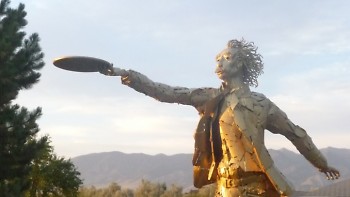Every year, shortly after the Top Ten is announced at ArtPrize, a panel is assembled and a public audience compares notes with the arts professionals, in what originated as a larger-scale version of what art students remember as the "crit."
This year's panel was comprised of three art professionals: Hrag Vartanian, editor-in-chief at Hyperallergic; Tori Pelz, Executive Director of Culture Works and Christopher Smit, professor of communication arts and sciences and author.
The friendly banter between the panelists and the educated analysis of each of the top ten pieces was informative and entertaining, and it was clear that they were well-chosen for the task.
The event, however, was noticably missing the more contentious or outspoken critiques of past years, and audience interaction was limited to a short portion at the end.
Kevin Buist, Director of Exhibitions at ArtPrize, explains that the first year was for many more hurtful than productive. Artists became defensive; panelists didn't want to return and be the bad guy again.
"In the following years, the energy never quite returned. The panelists would sort of self-edit or censor, because they could just obliterate something but then it wouldn't really be edifying for anyone," he says.
So instead, this year, a compare-and-contrast lateral conversation was created. The idea was to put each piece up against a similar work, and to ask questions in comparison rather than letting the conversation boil down to a simple but less helpful "is this good or not" analysis.
I was hoping for more audience interaction, and to be honest I missed that contentious energy of the first year.
Perhaps, according to Vartanian, there just wasn't as much to be contentious about.
"I feel like people were kind of pleasantly surprised at the list, because after seeing the list last year, the question was 'what could be the worst possible scenario,'" says Vartanian.
It may also be that the panelists brought in this time may have had a more post-modern view of how we ascribe value to art.
"In my idea of art criticism, there isn't just one answer," says Vartanian. "I don't feel like if I have one opinion about something…there isn't just one answer. I can understand that this might work for you, but it doesn't work for me. There were a lot of those works I didn't like, and I admitted it. That's fine, but you're welcome to like it- but you have to tell me why."
Maybe it's not post-modern, perhaps it is just the recognition that we can learn from each other. That kind of attitude, lead by example in the professionals, just may be when we can really embrace the possibilities for learning through our experiences at ArtPrize.
"That's how opinions are made is through consensus. It comes through discussion," Vartanian says. "I could decide if something is the greatest without any other opinions and discussing it, and she may have a different opinion that opens my eyes up- I'm open to that."
The Rapidian, a program of the 501(c)3 nonprofit Community Media Center, relies on the community’s support to help cover the cost of training reporters and publishing content.
We need your help.
If each of our readers and content creators who values this community platform help support its creation and maintenance, The Rapidian can continue to educate and facilitate a conversation around issues for years to come.
Please support The Rapidian and make a contribution today.
